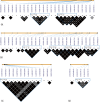Genome Wide Association Analysis Reveals New Production Trait Genes in a Male Duroc Population
- PMID: 26418247
- PMCID: PMC4587933
- DOI: 10.1371/journal.pone.0139207
Genome Wide Association Analysis Reveals New Production Trait Genes in a Male Duroc Population
Abstract
In this study, 796 male Duroc pigs were used to identify genomic regions controlling growth traits. Three production traits were studied: food conversion ratio, days to 100 KG, and average daily gain, using a panel of 39,436 single nucleotide polymorphisms. In total, we detected 11 genome-wide and 162 chromosome-wide single nucleotide polymorphism trait associations. The Gene ontology analysis identified 14 candidate genes close to significant single nucleotide polymorphisms, with growth-related functions: six for days to 100 KG (WT1, FBXO3, DOCK7, PPP3CA, AGPAT9, and NKX6-1), seven for food conversion ratio (MAP2, TBX15, IVL, ARL15, CPS1, VWC2L, and VAV3), and one for average daily gain (COL27A1). Gene ontology analysis indicated that most of the candidate genes are involved in muscle, fat, bone or nervous system development, nutrient absorption, and metabolism, which are all either directly or indirectly related to growth traits in pigs. Additionally, we found four haplotype blocks composed of suggestive single nucleotide polymorphisms located in the growth trait-related quantitative trait loci and further narrowed down the ranges, the largest of which decreased by ~60 Mb. Hence, our results could be used to improve pig production traits by increasing the frequency of favorable alleles via artificial selection.
Conflict of interest statement
Figures






References
-
- Nissen PM, Jorgensen PF, Oksbjerg N. Within-litter variation in muscle fiber characteristics, pig performance, and meat quality traits. Journal of animal science. 2004;82(2):414–21. . - PubMed
-
- Andersson L, Haley CS, Ellegren H, Knott SA, Johansson M, Andersson K, et al. Genetic mapping of quantitative trait loci for growth and fatness in pigs. Science. 1994;263(5154):1771–4. . - PubMed
Publication types
MeSH terms
LinkOut - more resources
Full Text Sources
Other Literature Sources
Miscellaneous

